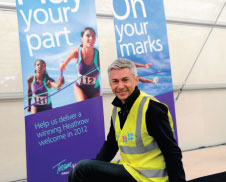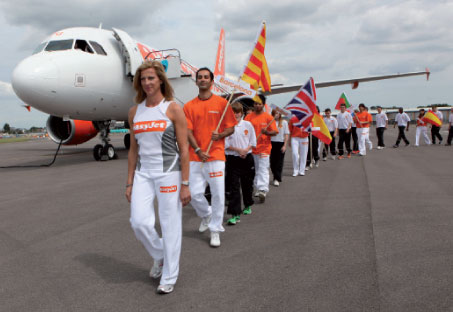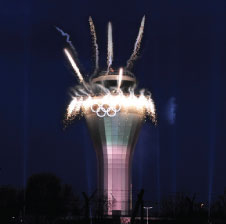
A ‘Topping Out’ ceremony was held for London-Heathrow’s Games Terminal in April. Jonathon Edwards CBE, former Triple Jumper and Olympic, Commonwealth, European and World Champion, was Guest of Honour at the ceremony.
In passenger traffic terms, London is the most popular air destination in Europe and each year welcomes more visitors than any of its mainland counterparts. This year, the Olympic Games present a unique challenge to the aviation community. According to UK Department for Transport (DfT) figures, more than 500,000 international visitors are expected during the period of the Olympic Games – 27 July to 12 August – the majority travelling by air. London has excellent international air transport links, however capacity will need to be managed carefully to meet the additional demand without congestion or delays. While certain activities at the airport remain beyond their control – the Border Control delays experienced at London-Heathrow in May being a much-publicised recent example – airports have been working diligently with the relevant authorities and aviation partners to ensure operations are as smooth as can be predicted.
Heathrow Games Terminal
As the designated ‘Host Airport’, London-Heathrow will handle around 80% of all Olympic-related traffic to London. The figures show the scale of the task at hand for the airport, which already operates at 99.2% capacity; on 26 July, the day before the Games begin, it will handle 138,000 arrivals – a 45% increase on a typical day. A similar number of departures are expected on 13 August, the day after the closing ceremony, when the airport will be at 100% capacity. “We are assuming that every single seat leaving Heathrow will be filled and this is something that we’ve never experienced before. Another thing to consider is the change in transfer traffic. On a normal day, 65% of traffic departing Heathrow would be direct, but this will increase to 87% and this gives us an issue to deal with in terms of baggage and passenger capacity,” explained Nick Cole, Head of Olympic and Paralympic Planning, London-Heathrow.

The ‘London 2012’ shop at London-Stansted Airport was officially opened by Wenlock and Mandeville – mascots for the Olympic and Paralympic Games.
It seems difficult to overstate the extensive preparations that Heathrow is undergoing. At time of press, the airport was about to announce that it has become the 5th airport in Europe to fully implement Airport Collaborative Decision-Making (A-CDM), which will result in timely exchange of vital information between all the relevant operational stakeholders, lowering idle time on the ground and helping optimise operations.
Front of house, a key part of the airport’s preparations is its Games Terminal – a temporary facility, built on the site of a staff car park, which will be used by departing athletes and officials for three days after the Olympic Games. No flights will leave from the Games Terminal; athletes and officials will go through the check-in and security process there before being transported by bus to their departure terminals. This means that 10,100 travellers and 38,000 bags will be diverted away from the main terminals. “One of the things we are focused on is making sure it’s not just a great experience for those passengers who are going to the Games, but also all of the other passengers as well. By having a dedicated Games Terminal, this will preserve the rest of the airport, so it should feel just like a busy summer’s day,” said Cole. “We will also have remote check-in facilities in the Olympic Village. We’ll get the bags off those departing the Village the night before they are due to fly and we will start processing these bags overnight.”
London-Heathrow is focused on that all-important first impression and the airport will be decorated with an Olympic theme. 1,000 volunteers have also been recruited from local communities to assist travellers. “The volunteers will play a big part. The first impression is absolutely vital,” commented Cole.
It is a theme also picked-up by London-Stansted, the closest major international airport to the Olympic Village in Stratford, east London, which will have a special ‘London 2012’ Welcome Desk. A team of London Ambassadors will be on-hand to offer visitors advice on transportation, wayfinding, tourism and event venues. The airport is also working closely with a number of local partners to create a sense of fun in the terminal building during the Games; local sports-related charities, for example, will stage a number of mini sporting events in the terminal.
London-Stansted’s spare capacity means it is well-placed to handle increased passenger and baggage numbers. It is working closely with airline partners, handling agents and the Games organisers to ensure efficient, smooth operations. “All companies and organisations operating on the airport, or who have a direct responsibility for managing passenger facilities or processes, have come together as ‘Team Stansted’ to prepare and deliver the plan to ensure London-Stansted operates as smoothly as possible,” explained Nick Barton, Managing Director, London-Stansted. “Special teams of volunteers and ambassadors are being trained to ‘meet and greet’ Olympic-related visitors, which will allow our operational staff to look after our ‘business as usual’ passengers.”

Olympic gold medallist Sally Gunnell was on-hand to celebrate the announcement of London-Southend Airport as easyJet’s 20th base.
Whilst not an official port of entry, London-Gatwick Airport is looking forward to welcoming athletes, VIPs, officials, media and spectators, and is expecting to handle around 10% – or 70,000 – more passengers compared to a normal busy summer day.
Over 150 airport staff volunteers will be on hand to answer passenger questions, as well as hosting around 300 Greater London Ambassadors. A ‘Travel Hub’ on the airport’s website will give passengers real time route planning advice as they travel to and from the airport. Richard Townsend, Olympic Lead at Gatwick Airport said “Over the past two-and-a-half years we have been modernising and upgrading the airport through a £1.2 billion (11.5bn) investment programme to transform the passengers’ experience of the airport. This investment has ensured we are fit-for-purpose during the Games and beyond.”
With an investment of over £500 million (1617m) so far upgrading and modernising the airport facilities, passengers will benefit from speedier check-in with more self-service options available; efficient security as passengers go through within five minutes or less 95% of the time; dedicated lanes in security and the immigration halls for reduced mobility passengers and families with young children; and more modern and spacious arrivals halls, forecourts and interchange facilities in both terminals.
It will be business as usual at London City Airport over the summer season, as the airport’s 10 customer airlines continue to serve 42 mainly European and domestic destinations. As a result of the London 2012 Olympics, a change is expected in the usual 65%/35% business/leisure passenger mix, as there will be less business and more leisure passengers using the airport.
Overall, there should be a slight uplift in passenger numbers and there will be an Olympic ‘pod’, manned by Olympic ambassadors, in the terminal building to provide information about London and the London 2012 Olympic Games to those passengers who require it. In addition, the airport will welcome several hundred athletes, mainly from Switzerland, Lichtenstein and Team GB as they pass through the facility, and will be putting its support behind LCY-sponsored high jumper (and Irish Athlete of the Year), Deirdre Ryan.
Declan Collier, CEO, London City Airport and ACI EUROPE President, believes the airport’s prime location in the middle of the main Olympic venues makes it a uniquely convenient gateway to the Games, as well as to London itself. “Three miles away from the Olympic Park, two miles from the North Greenwich Arena and less than a mile from ExCeL – LCY could not be closer to the action and it would be perfectly possible for ticketholders from overseas to fly in and out on the same day,” he said. “We are expecting some extra traffic over the period, and we’ve ensured that we are fully staffed and able to manage the peaks associated with the Games. That being said, we also have a loyal, regular customer base to cater for and for them it will be business as usual – a 20-minute check-in time (from door to gate) and a 10-minute arrival time (from wheels-down to taxi rank).”
Infrastructure developments
Several airports have invested in infrastructure improvements, leaving them well-equipped to handle the impact of the Olympic Games. This is particularly true of London-Southend Airport, which has a new 3,600sqm terminal and a new railway station that, significantly, provides a direct link to the Olympic Park. The airport expects an increase in the number of private and business jets throughout the Games and, in preparation, has brought forward its plans to increase aircraft parking. A new 4-star hotel will also open in time for the Olympics. “London-Southend is the only UK airport with a direct mainline rail connection with the Games at Stratford. The new train station offers up to eight services per hour to and from London – a seamless link between the airport and the Olympic Park at Stratford in just 44 minutes and central London in just 53 minutes,” said Alastair Welch, Managing Director, London-Southend Airport.
London-Luton has also made improvements; developments to its central terminal area, drop-off zone and short-term car park are designed to improve capacity and passenger flow. Additional security lanes are also being installed in the terminal to ensure efficiency in peak times, with staff numbers being increased. The airport, like London-Stansted, will also host London Ambassadors to offer advice to visitors. Glyn Jones, Managing Director, London-Luton Airport, commented: “We expect 65,000 passengers over the Olympic period, 31,000 of these passengers being additional traffic. Out of the additional passenger traffic, 26,000 passengers will travel on existing scheduled services, the remaining 5,000 are anticipated to travel on specially chartered aircraft.”
Towering success
It is not only the London airports that are embracing the Olympic spirit. Birmingham Airport has unveiled a spectacular set of Olympic rings on its Air Traffic Control tower in celebration of the Games. The rings, which have been privately funded by the airport, were launched in April at a special event attended by Olympic and Paralympic Gold medallists Edwin Moses and Lee Pearson.
“The Olympic Games are for the entire country, not just London. Every visitor, passenger and passerby will see our welcome spectacular and we’re really proud to be part of such a historic occasion,” said Paul Kehoe, Birmingham Airport CEO. “Both the Jamaican and US Olympic Track and Field teams are training in Birmingham prior to the Games and the neighbouring city of Coventry will host several football matches. The Midlands region will have a big role to play during the Olympic and Paralympic Games, so we want everyone flying into Birmingham for the occasion – whether they’re athletes, spectators, officials or members of the world’s media – to have a special welcome.”
OmniServ’s Summer of Sport preparations
OmniServ under it’s brand ‘Air Care’ is the current supplier to Heathrow Airport and all 94 airlines for services related to Passengers with Reduced Mobility, a service which is used by approximately 76,000 passengers per month. The Paralympic Games will see a significant increase in service requirements when some 4,500 Paralympian athletes transit through Heathrow en route to and from the various stadia. In preparation for the huge influx in passengers, OmniServ has been working with key stakeholders, including Heathrow Airport, airlines and ground handling agents, to devise strategic plans and logistical processes to deliver a robust and efficient operation. “Above all, safety is paramount and employees are undergoing training and taking part in live trial flights that have been conducted to test our process methods for managing multiple aircraft offload an on-load of Paralympian athletes,” explained Antony Marke, Director of Passenger Services, OmniServ.
OmniServ, in cooperation with Heathrow Airport, has purchased new lightweight collapsible aisle chairs. These will enable an efficient streamlined operation onboard the aircraft in transferring athletes from their aircraft seat in the cabin up to their personal day chairs, which will be brought to the aircraft door from the aircraft holds. “As a contingency, we have also purchased self-propelled wheelchairs, which will be on standby in case of any unfortunate damage or loss of chairs in transit to Heathrow, allowing athletes to continue their journey through the terminal,” added Marke. “OmniServ has also converted two A380 highlifts to be able to carry between 15 and 20 athletes to and from the terminal if necessary due to high volume flight arrivals.”
OmniServ is conducting numerous test trials with its aisle chairs on a hangar-based aircraft courtesy of BMI, and carrying out highlift training on Qantas A380s to perfect the multiple offload and on-load processes that will be implemented during the Games period. These trials were then put into live practice with successful Paralympic test events held in London during April.
Air space preparations
Alongside the comprehensive preparations being made by airports on the ground, significant planning has taken place to manage the increased demand for air space. NATS, the main air navigation service provider in the UK, is planning for around 4,000 additional flights in the UK during the Olympics period. “We are ready and able to manage this extra demand – that is what we have been preparing for. But adverse weather, flights not sticking to their slot allocations, or security alerts could disrupt the system and may lead to delays,” said Paul Haskins, NATS General Manager Terminal Control. “Throughout the Games, we will liaise and provide advice to organisations across the aviation industry to ensure a coordinated approach to a safe, efficient operation, including using the NATS Air Traffic Incident Crisis and Communications Cell.”
NATS has been planning for the Games for four years, testing systems and liaising with partner bodies such as the Civil Aviation Authority, Department for Transport and Ministry of Defence. It has also consulted with airlines and airports. In order to safely manage aircraft during the peak demands of the Olympic Games, it has also designed extra controlled airspace in south east England – already one of the most complex areas of air space in the world.

Birmingham Airport has unveiled a spectacular set of Olympic rings on its Air Traffic Control tower in celebration of the Games. “The Olympic Games are for the entire country, not just London. Every visitor, passenger and passerby will see our welcome spectacular and we’re really proud to be part of such a historic occasion,” said Paul Kehoe, Birmingham Airport CEO.
“In order that we can maintain our excellent safety record and manage the extra flights in and out of the London area, we have, with the CAA, created temporary controlled air space (CAS (T)). CAS (T) is designed to create sufficient capacity and separate flows, so that the demand projected by other temporarily coordinated airfields can be satisfied,” explained Haskins.
EUROCONTROL, in its role as Network Manager, is working closely with NATS and the UK CAA to ensure that air space demand can be handled. Detailed simulations have been completed to help achieve a realistic impression of the traffic surges. Demand estimates will then be regularly reassessed. In addition to the main London airports, 35 smaller UK airports will be included in Europe’s flow management system during the Games. This means that aircraft heading for these airports will require slots, and flight plans will be mandatory over a much wider area than usual.
Jacques Dopagne, Director of Network Management, EUROCONTROL, commented: “The 2012 Olympic and Paralympic Games will have a significant impact on air traffic management, both in the UK and more widely across Europe. As Network Manager, EUROCONTROL is working very closely with the UK authorities to make sure that traffic flows as smoothly and safely as possible. During the last meeting of all Directors of Operations, it was noted that the preparations for the Games were well in hand.”
With around 500,000 international visitors expected, the UK’s airports have a vital role to play in the success of London 2012. They will provide the all-important first impression, welcoming visitors from around the world. It is a major challenge and one that the airports have embraced, with many infrastructure developments completed in preparation and special events planned by some airports in their efforts to provide the best possible passenger experience.







